
The Business of Fashion
Agenda-setting intelligence, analysis and advice for the global fashion community.

Agenda-setting intelligence, analysis and advice for the global fashion community.
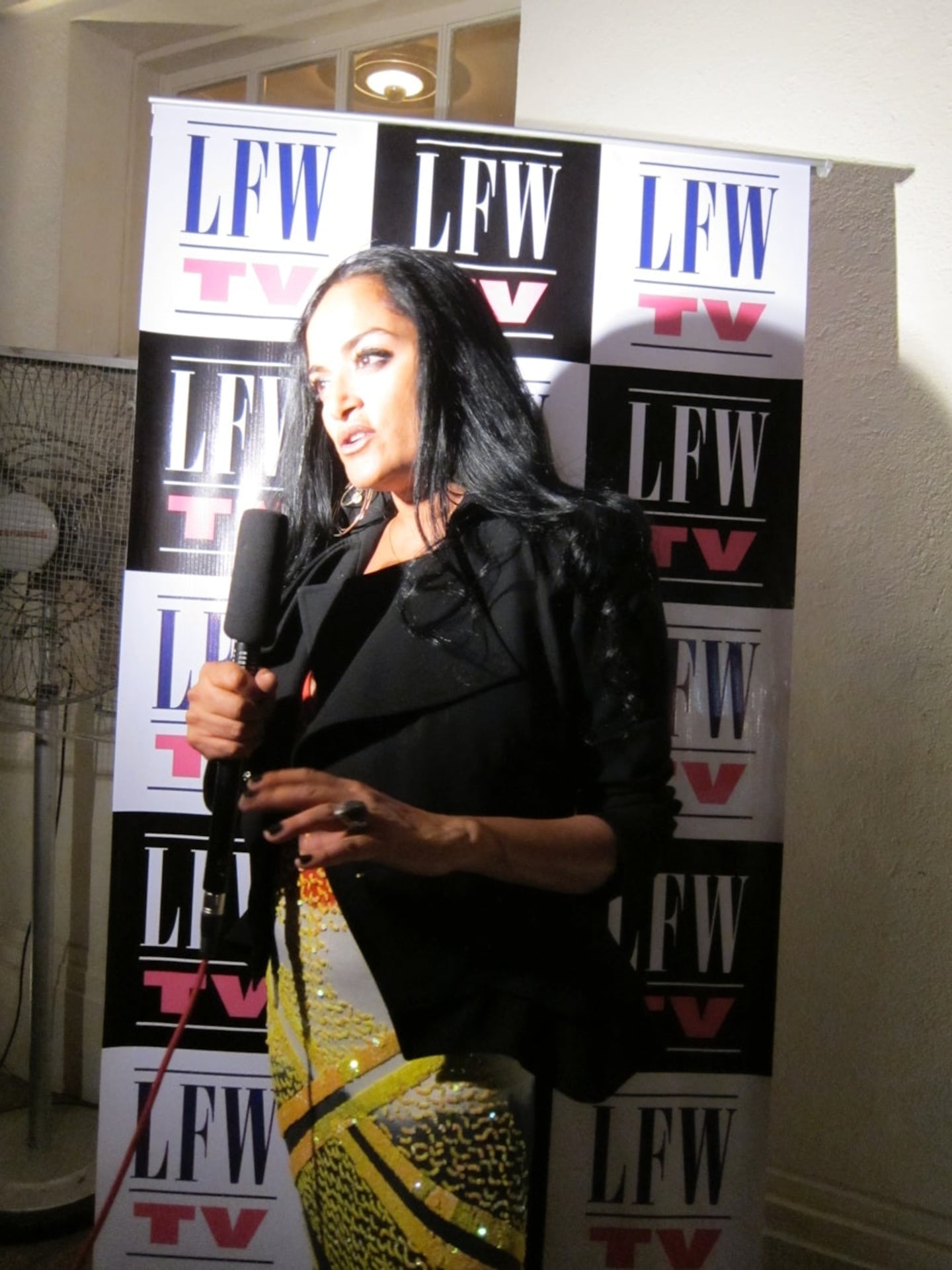
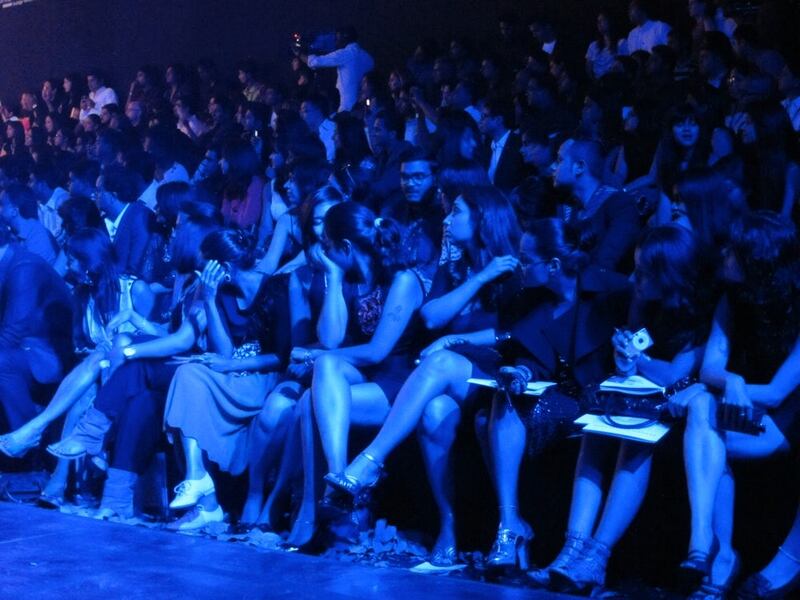
Front Row at Lakmé Fashion Week | Photo: BoF
MUMBAI, India – From the minute I landed in Bombay—as everyone here still calls it—the rapidly shifting nature of contemporary India was apparent. Instead of waiting in agonisingly long queues at the airport, I breezed through immigration, customs and bag collection in only 45 minutes. That's faster than one can make it through most terminals at Heathrow or JFK these days.
Outside the airport, cranes building a new terminal towered over those waiting with signs to pick up arriving international passengers with names like Padamsee and Singh, but also Takahashi and Levine, signs of the globalisation that is quickly transforming this city into an international melting pot.
The last time I attended a fashion week in India was five years ago, so when IMG kindly invited me to attend this season’s Lakmé Fashion Week, I was curious to see how things had changed. With GDP growth racing along at a blistering 8 percent per year, and a growing sense of national pride, there were bound to be changes in India’s fashion business landscape as well.
ADVERTISEMENT
INDIA IN FOCUS
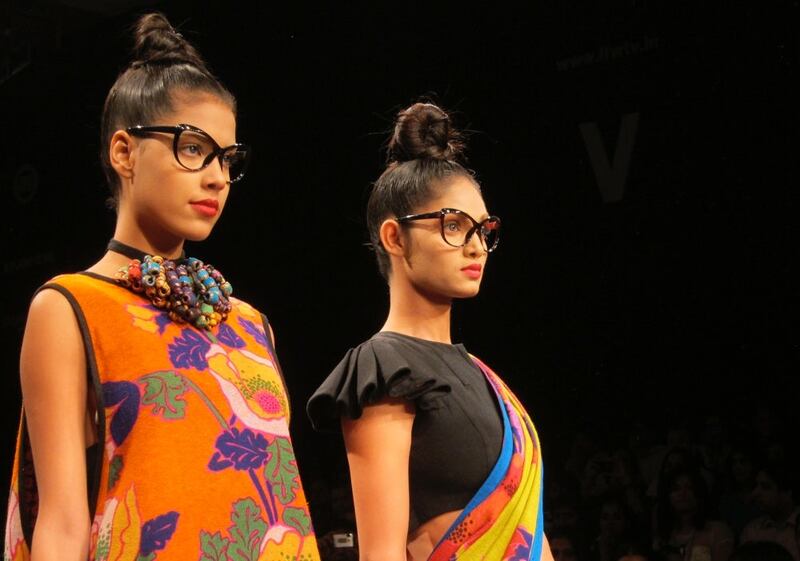
Sabyasachi Summer/Resort 2011 | Photo: BoF
In his new book, India Calling – An Intimate Portrait of a Nation's Remaking, author and New York Times online columnist Anand Giridharadas writes that "the deepest change I witnessed in India was…in how people conceived their possibilities. Indians now seemed to know that they didn't have to leave…to have their personal revolutions."
By the same token, the deepest change I noted in my conversations with Indian fashion designers this time around was that instead of trying in vain to conquer an over-saturated and hyper-competitive international industry, they now have their sights set on a nascent market at home that is showing growing signs of consumerism and interest in fashion.
Sabyasachi Mukherjee, one of the country's brightest fashion stars whom I first met when he was showing in New York, said that he decided to pull back after struggling to gain traction abroad and sensing a growing opportunity at home. According to a 2009 study by Grail Research, the market for Indian designer fashion was expected to grow 178 percent between 2008 and 2012, reaching a small, but respectable $189m a year, still only a fraction of one percent of the global market.
"If you look at the Indian market, it is becoming stronger and stronger. It would be foolish not to address that challenge and possibility," he says. "I think it's very important for an Indian designer to consolidate his position in India first, make himself stronger and then take his brand international as opposed to the other way around."
The results of this new focus were evident on the runway, as Mr. Mukherjee put on the best show of the week, both in terms of the collection itself and the styling, choreography and music.
"A lot of Indian women like wearing clothing which defines them as Indian," says Mr. Mukherjee. "I might be doing Western clothing, I might be doing Indian clothing, but there is always a common denominator, and that is India. If you look at the approach, if you look at the artistry, if you look at the textiles, there's always a strong indigenous feel."
ADVERTISEMENT
Even some of the strongest emerging designers at Lakmé Fashion Week like Shivan and Narresh, whose design sensibilities are more Westernised, said they wanted to build foundations in India before making any concerted efforts to go abroad.
This is the right choice. The country’s cultural traditions, craftsmanship and climate make the Indian fashion market a tough one for foreign brands to penetrate, so local designers have a distinct home-turf advantage.
WHY TWO FASHION WEEKS?
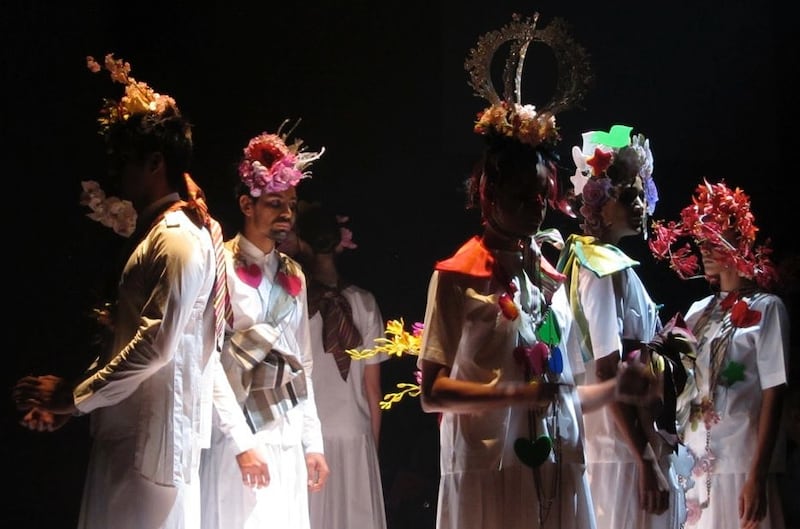
Little Shilpa Summer/Resort 2011 | Photo: BoF
One cannot discuss fashion in India without discussing its highly politicised fashion system. Once upon a time, there was only one major fashion week, put on by the Fashion Design Council of India (FDCI), produced by IMG and sponsored by Lakmé, the country’s largest cosmetics company.
But in late 2005, when the FDCI controversially tripled the event sponsorship fee and found a new production partner, IMG and Lakmé decided to set up their own event in Bombay, splitting the Indian fashion community in two and creating a rift that has endured until today.
Many of the more established and commercially successful fashion designers chose to show at FDCI’s 'official' event in Delhi, while IMG-Lakmé attracted those with links to Bollywood and strong personal relationships with the organisers. Over time, Lakmé Fashion Week also emerged as the country's premier launching pad for young design talent, through a variety of programs designed to cultivate and promote new names, something that the fashion establishment in Delhi was loathe to do, at least at first.
Still, this means that buyers, editors and international guests need to attend both fashion weeks to get a full picture of the market here, or that designers need to show at both fashion weeks to reach the full audience.
ADVERTISEMENT
We have made this point before, but the Indian fashion industry would benefit greatly from a single, consolidated fashion week. As it stands, organisers appear to be struggling to fill five days of show slots in both cities with collections that truly merit runway exposure. Too many of the collections this week were poorly made, in cheap fabrics, without a clear design point of view or consumer target.
In short, the standards for showing at either fashion week India remain too low. Instead of having two fashion weeks with a few patches of excellence in a sea of mediocrity, India could have one strong fashion week with truly exacting standards, creating an incentive for all designers to up their game and lifting the quality overall.
However, that doesn’t look likely to happen. Most people I spoke to seemed to think a reconciliation was nigh impossible, the tension between the two camps being so pronounced. For the time being at least, India will continue to have two fashion weeks, neither of which really brings to bear the full business and creative potential that this country has to offer.
A FASHION WEEK FOR CONSUMERS
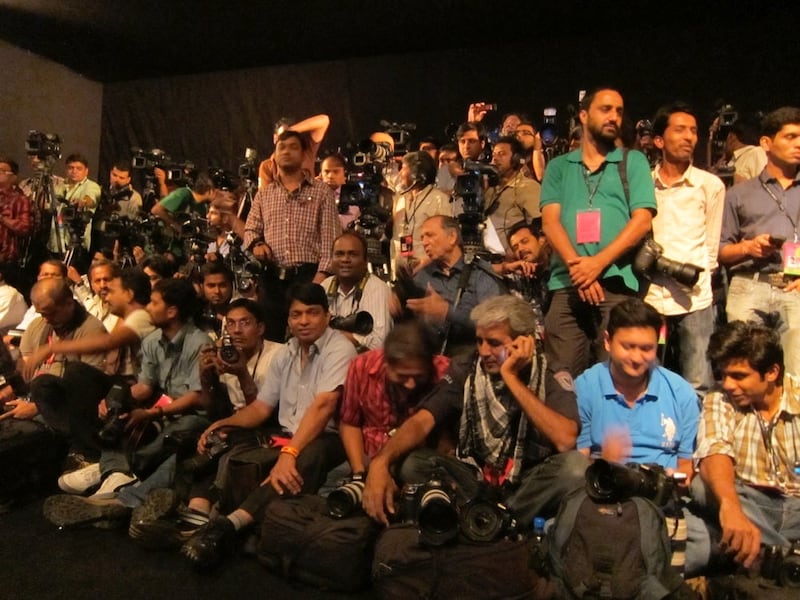
Photographers pit at Lakme Fashion Week | Photo: BoF
At Lakmé Fashion Week, there were only 190 buyers present this season, with 95 percent of the business and the lion's share of buyers coming from within India, and buyers from the Middle East making up most of the balance.
But actually, that might be okay. As the fashion industry elsewhere grapples with the rise of consumer participation, Lakmé Fashion Week is not just tolerating it, but is embracing its consumer side. It’s a clever way of differentiating itself from its Delhi counterpart, which has proven marginally stronger in terms of wholesale trade and international buyers.
Fueled by the undeniable power of Bollywood and the voracious Indian media, Lakmé Fashion Week generates pages and pages of column inches, thousands of photos, and hours of television coverage every day. There are as many photographers in the pit here as there are in the main fashion capitals – except that they are all from the domestic market. It's hard to fathom, but there are over 50 dedicated news channels alone on Indian TV, which along with the live-streaming of shows, brings fashion week straight to consumers all over this vast country, in several different languages.
One problem with this kind of media frenzy is that there are few commentators and observers qualified to review and report on the collections. The arrival of Vogue, by many accounts, has lifted the overall standard of fashion reporting, but still most of the attention is paid to the Bollywood stars who sit in the front row and who walk the runway to deliver 'show-stoppers.' Some of the collections are an after thought, and in some cases have nothing to do with what is actually available for sale.
There are some brands and businesses, however, which are using the Lakmé Fashion Week platform in a more commercially savvy way. Whereas most fashion weeks at this time of year—including the FDCI fashion week in Delhi—focus on Autumn/Winter 2011, Lakmé Fashion Week designers were showing Summer/Resort 2011 collections, some of which will actually be available to consumers in store and online in a matter of weeks.
As Pearl Uppal, chief-executive and co-founder of Fashion and You—India's rapidly growing answer to Gilt Groupe and a sponsor of Lakmé Fashion Week—explained, following a successful trial last season, capsule collections from several emerging designers will be available on the website in only 21 days. Likewise, the stylish Sabina Chopra who regularly appeared in fresh-off-the-runway Sabayasachi, and works with the designer on business development, reported that the entire runway collection will be available in the brand's stores in a matter of weeks.
How do they do that, you ask? Most Indian designers control or own the means of production and are therefore able to prioritise the manufacture of small volumes right after fashion week to capitalise on the consumer buzz generated by catwalk shows, something most Western brands are still struggling to do.
SPONSORSHIP, TO THE POINT OF DISTRACTION
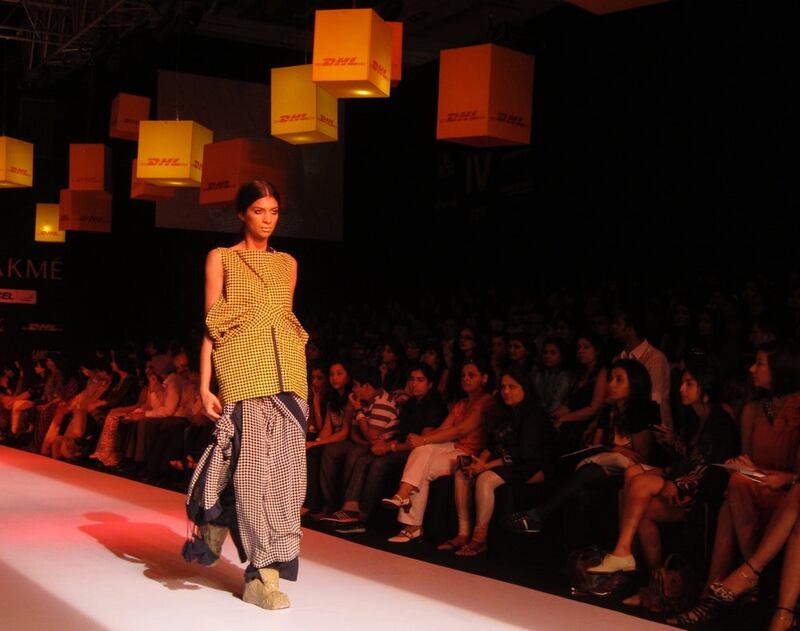
Kallol Datta at Lakmé Fashion Week | Photo: BoF
But the consumer-focused nature of Lakme Fashion Week also has its pitfalls. Taking a cue from Lincoln Center in New York, Lakmé Fashion Week is an important money spinner for IMG, and most of that revenue is generated from sponsorship deals with the likes of Lakmé, but also a host of other companies including Aircel, a mobile phone provider, Blenders Pride, a liquor company, and Lavazza, the coffee company.
Everywhere you look there is a company logo or a brand-sponsored booth. In a consumer-oriented environment this kind of branding seems alright, and IMG of course needs to make money from the event, but the right balance must be struck in order to maintain the event's integrity and so designer collections can be shown in the best way possible, without unnecessary distraction.
Unfortunately, this was not always the case. There were times when the branding at Lakmé Fashion Week simply went too far. At the 'DHL Future of Fashion' show, emerging design talents Atsu Sekhose and Kallol Datta had been instructed to draw inspiration from the colours of the DHL logo. When the yellow and red collections appeared, bathed in yellow DHL light, under yellow and red DHL boxes hung like lanterns all the way down the runway, a line was crossed into crassness during the shows of two of the most hotly-tipped talents of the week.
While events like these would be impossible without sponsors like DHL, they must also be willing to do so in a way that enhances the designer presentations, not detract from them.
AN OPTIMISTIC FASHION COMMUNITY

Gulshan Randhawa and Avni Doshi at LFW | Photo: BoF
Leaving the business and catwalk shows aside, the undoubted highlight of my week in Bombay was experiencing the infectious optimism of the people who are shaping the future of Indian fashion at this nascent stage. They might not yet have all the answers, but they are still excited for what lies ahead and seem willing and open to try new things. As a friend wrote to me upon hearing my reflections, being terribly jaded is a privilege of the overdeveloped 'first world'.
From new friends like Manou, India's answer to The Sartorialist, to old friends like the uber-smart fashion authority Bandana Tewari, the hospitality and kindness shown to me by the Indian fashion community was inspiring. I particularly enjoyed meeting the effervescent Bollywood costume designer turned fashion designer, Manish Malhotra—whose show was a beautiful celebration of the best in unashamedly Indian clothing—and chatting with Masaba Gupta, Shivan and Narresh and Little Shilpa, young designers who are creating their own fashion revolution here.
But far from being an Indian-only club, the fashion industry here also relies on talented individuals from around the world, many of whom plan to come for a few months, and end up staying here for years. Fern Mallis, who sat next to me during the shows whispering her words of wisdom and experience into my ears, has been coming to India for over ten years to advise IMG in getting Lakmé Fashion Week off the ground. Caroline Young, a sort of English fashion fairy godmother introduced me to many of the country's top new talents. And the kind Mathieu Gugumus Leguillon, who used to design at Lanvin under Alber Elbaz, was always decked out in the coolest menswear from The Bungalow, his line for the local lifestyle boutique Bungalow Eight (not to be confused with the New York and London nightclubs of the same name.)
Last but not least comes IMG South Asia managing director Ravi Krishnan and his stellar team, who organised a fashion week that ran like clockwork in a country where punctuality isn't always a priority. Thanks in particular to Amtosh Singh, Gulshan Randhawa and Anjana Sharma for helping me make the most of a trip that was ultimately too short. I hope to come back again very soon.
Imran Amed is founder and editor of the The Business of Fashion
This week’s round-up of global markets fashion business news also features Latin American mall giants, Nigerian craft entrepreneurs and the mixed picture of China’s luxury market.
Resourceful leaders are turning to creative contingency plans in the face of a national energy crisis, crumbling infrastructure, economic stagnation and social unrest.
This week’s round-up of global markets fashion business news also features the China Duty Free Group, Uniqlo’s Japanese owner and a pan-African e-commerce platform in Côte d’Ivoire.
Affluent members of the Indian diaspora are underserved by fashion retailers, but dedicated e-commerce sites are not a silver bullet for Indian designers aiming to reach them.